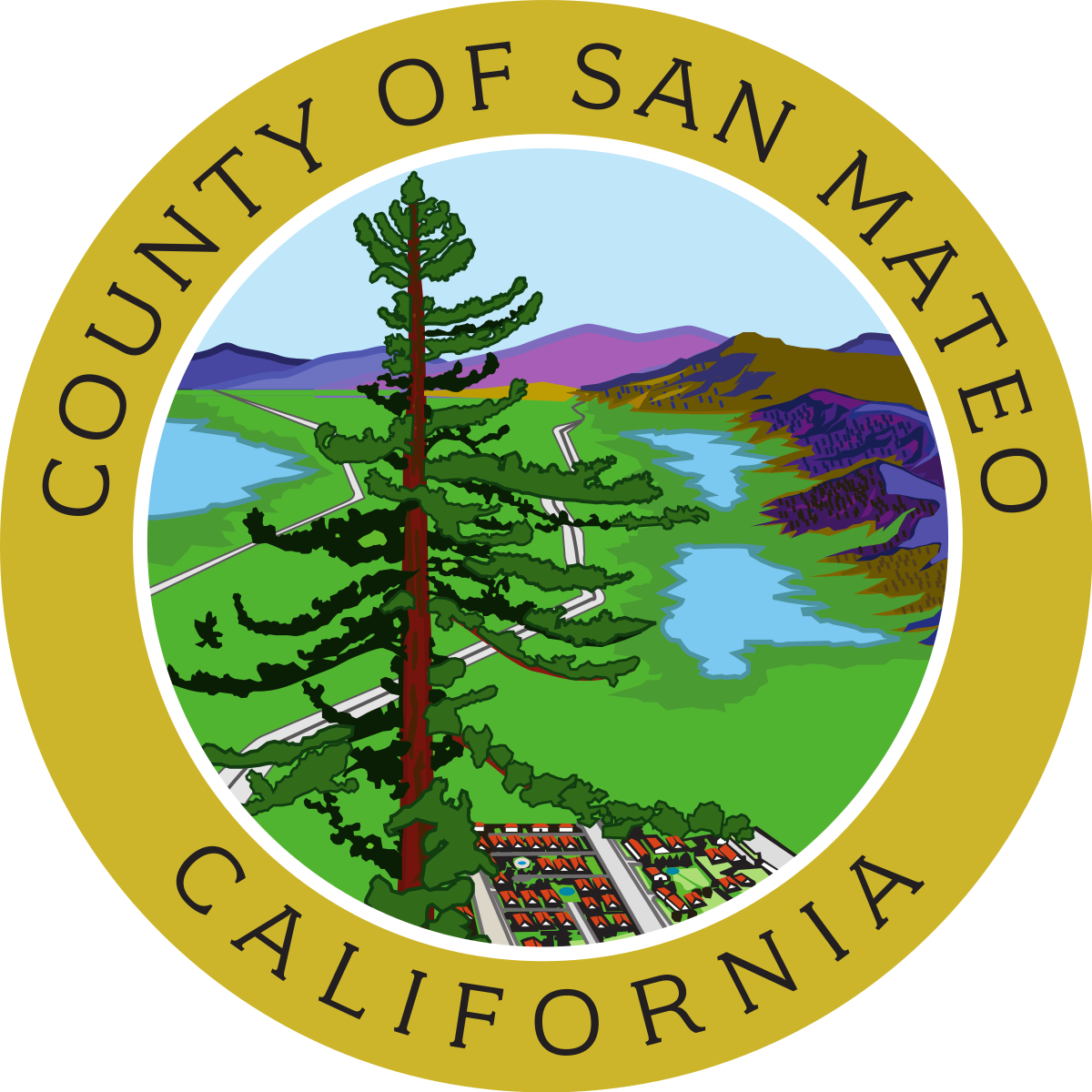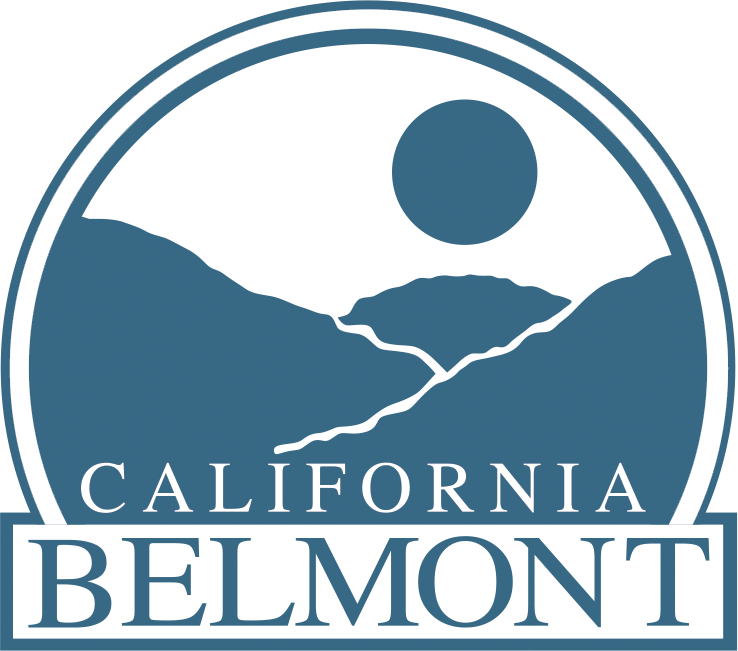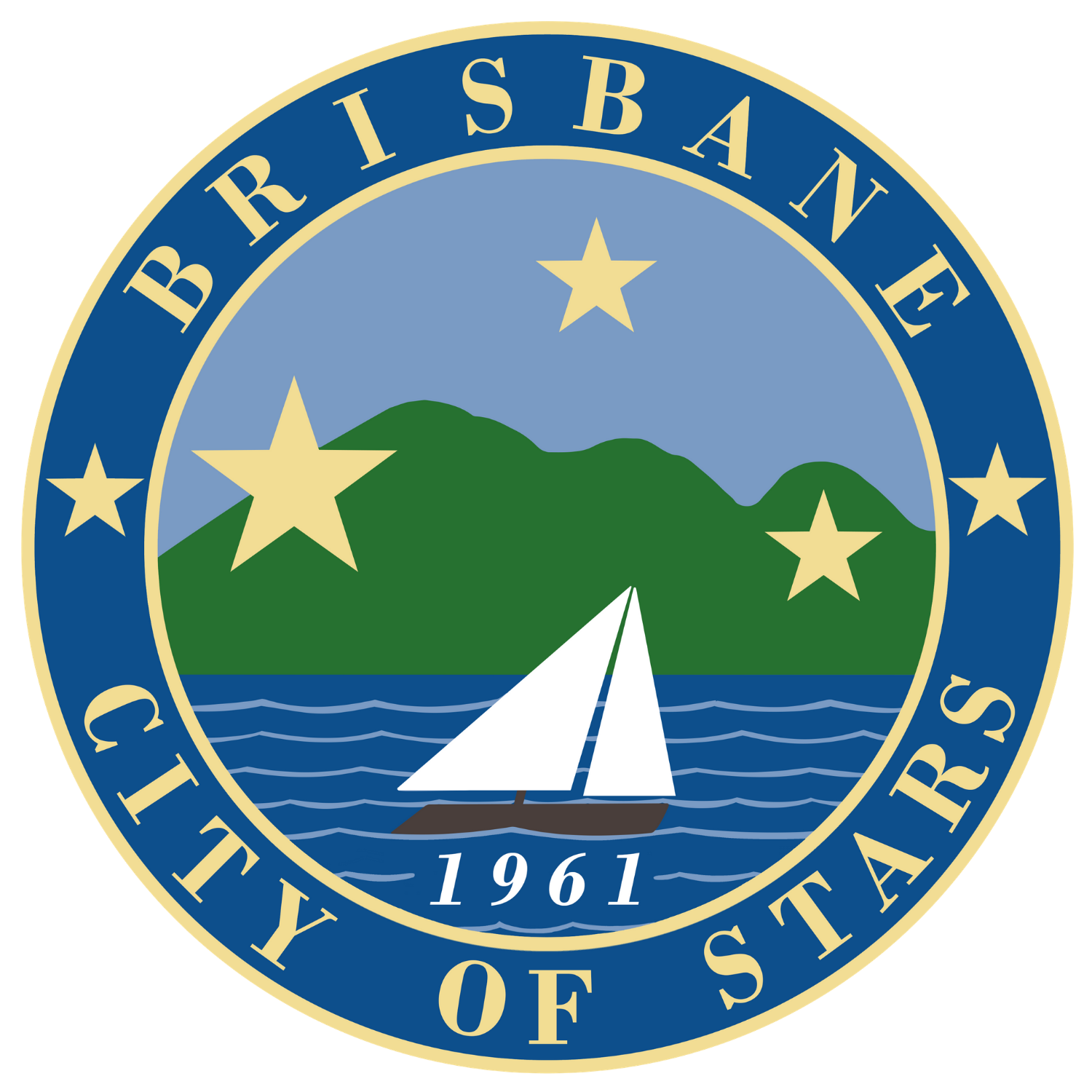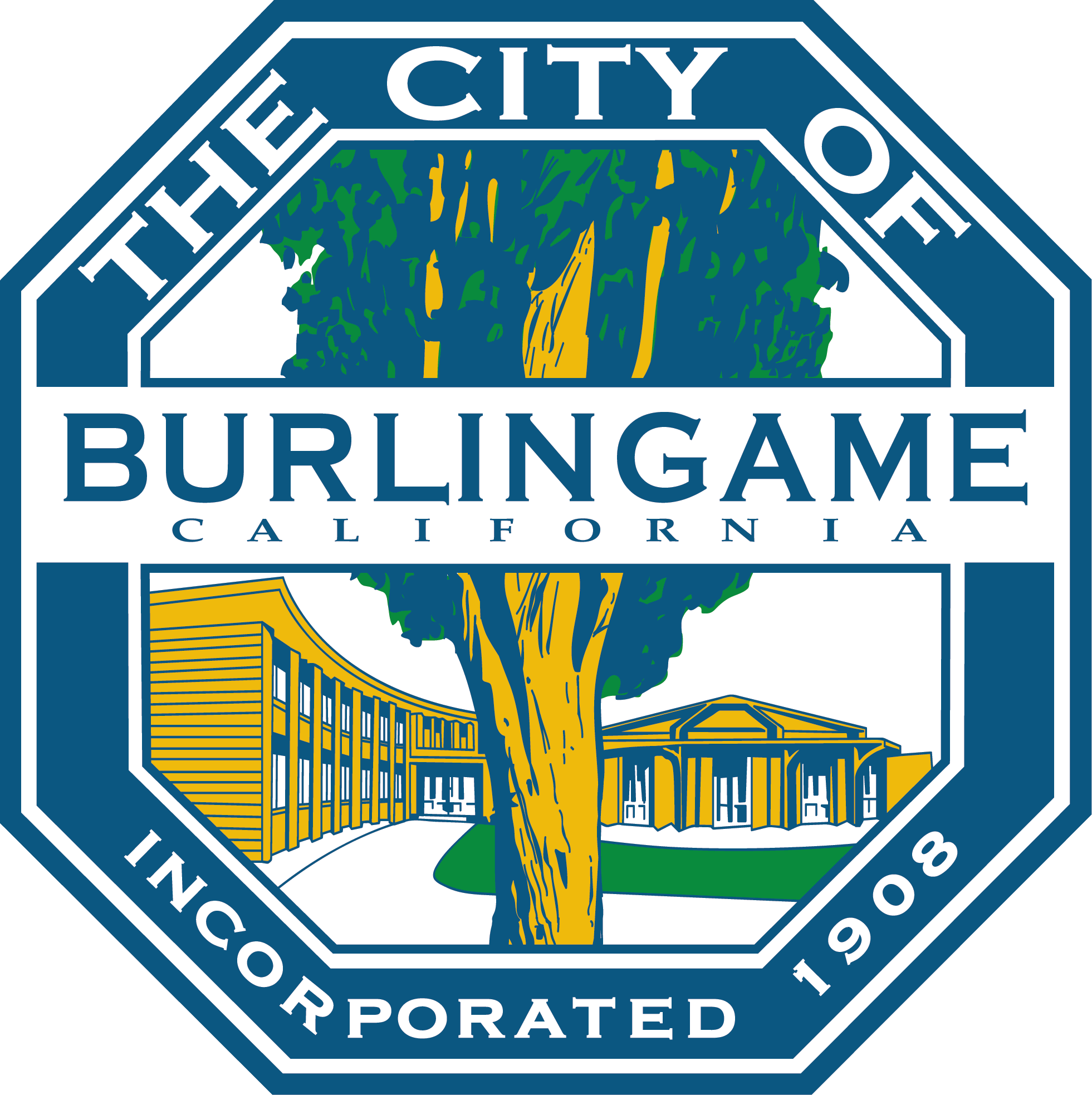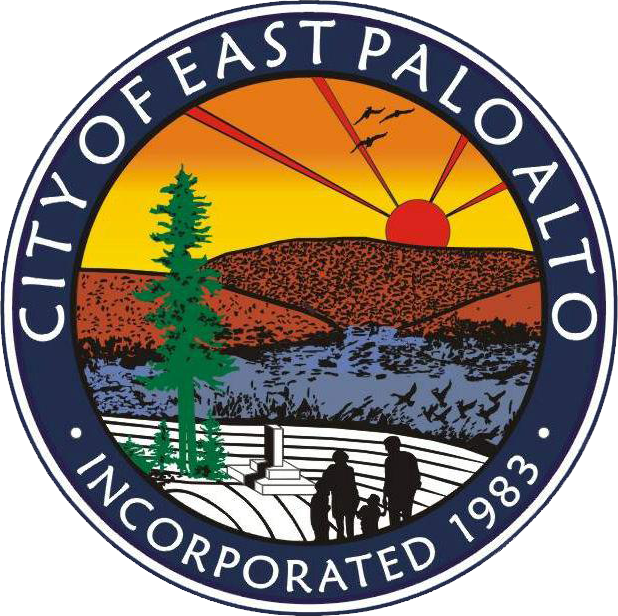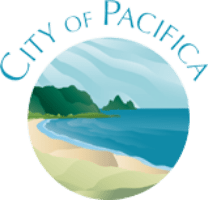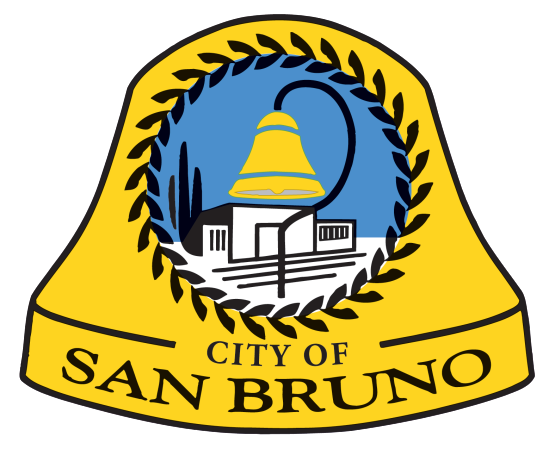Peninsula Resilience Planning Project
What is this Project?
San Mateo County, the Town of Atherton, and the cities of Belmont, Brisbane, Burlingame, East Palo Alto, Half Moon Bay, Pacifica, and San Bruno are working collaboratively on the Peninsula Resilience Planning (PREP) project. This project will help each local government plan for the harm posed by climate change and natural hazards, including updating the Safety Elements for many communities. A Safety Element is a required section of a city or county’s general plan that identifies potential natural and human-caused hazards that could affect residents, businesses, and services in the community. The purpose of the Safety Element is to establish a framework that anticipates these hazards and prepares the community to minimize the risks of these hazards. An important part of this project will be engaging residents, business owners, and community stakeholders to share their lived experiences, community knowledge, and expertise.
A consultant team is providing project management and technical assistance to the project. Community Planning Collaborative is serving as project manager to coordinate and communicate the needs of all agencies through the process. PlaceWorks is leading the technical and subject matter expert team, with support from Atlas Planning Solutions, Climate Resilient Communities, and Nexus Planning and Research.
The cities of Pacifica and Brisbane are participating in the Climate Change Vulnerability Assessment only in order to gain technical data and information for future work. Brisbane and Pacifica are not participating in the community outreach of the project since they are not updating their Safety Elements at this time. Atherton is conducting its own community outreach separate from the project. San Mateo County, Atherton, Belmont, Burlingame, East Palo Alto, Half Moon Bay, and San Bruno will prepare full updates to their Safety Elements.
This project also includes mapping of the areas at risk of natural hazards, along with maps of who and what in our communities are at risk. Please click the button below to access the online map viewer.

What is a Safety Element and why is it important?
A community’s Safety Element is a State-mandated component, or element, of a General Plan. A General Plan is the community’s blueprint for how and where communities will grow and use resources over the next few decades. The Safety Element discusses potential risks from natural and human-caused hazards and presents the community’s approach to avoiding or minimizing harm to people and the community from these risks. The State also requires local Safety Elements to analyze and identify their community’s vulnerability to climate change and climate-related hazards and to include goals, policies, and actions to reduce these vulnerabilities.
California residents understand that natural hazards are an inescapable and inherent part of life in our state, and San Mateo County is no exception. Lakes and streams shrink and swell in cycles of drought and downpours, hills and forests turn dry and burn, and the ground occasionally rumbles and shakes. Climate change increases the frequency and intensity of many of these hazards, often with increasingly severe effects.
We cannot ignore these hazardous conditions, nor can we eliminate the risks they pose. Ensuring the long-term health, vitality, and wellbeing of the diverse communities, natural features, and businesses of San Mateo County depends on finding ways to plan for long-term changes in these conditions and to increase our resilience to their harmful effects. With comprehensive resilience and hazard planning, we can reduce the chance of harm in our communities, design homes, businesses, and infrastructure to minimize hazard impact, and plan for rapid, effective responses and recovery when they do occur. The Safety Element of each jurisdiction’s General Plan serves as a comprehensive framework and foundation for community.
What does a Safety Element include?
A Safety Element identifies the hazards of concern in a community and includes detailed information and mapping as applicable for each hazard, describes the risks and projected changes over time of each hazard, assesses community climate change vulnerabilities, identifies evacuation-constrained parcels, and presents a set of goals, policies, and actions to reduce hazard severity and promote resilience. Goals are a desired outcome or end state from a particular effort. Policies and actions are steps that the community will take, either on their own or in partnership with other public agencies or community partners, to work toward and achieve their goals.
Hazards included in a Safety Element will vary by community, but they can include wildfire, flooding, earthquakes, landslides, extreme weather, sea level rise, pests and diseases, human health hazards, hazardous materials, and others. State law directs the inclusion of certain hazards, topics, and components as shown in the Safety Element Update Per State Law figure.
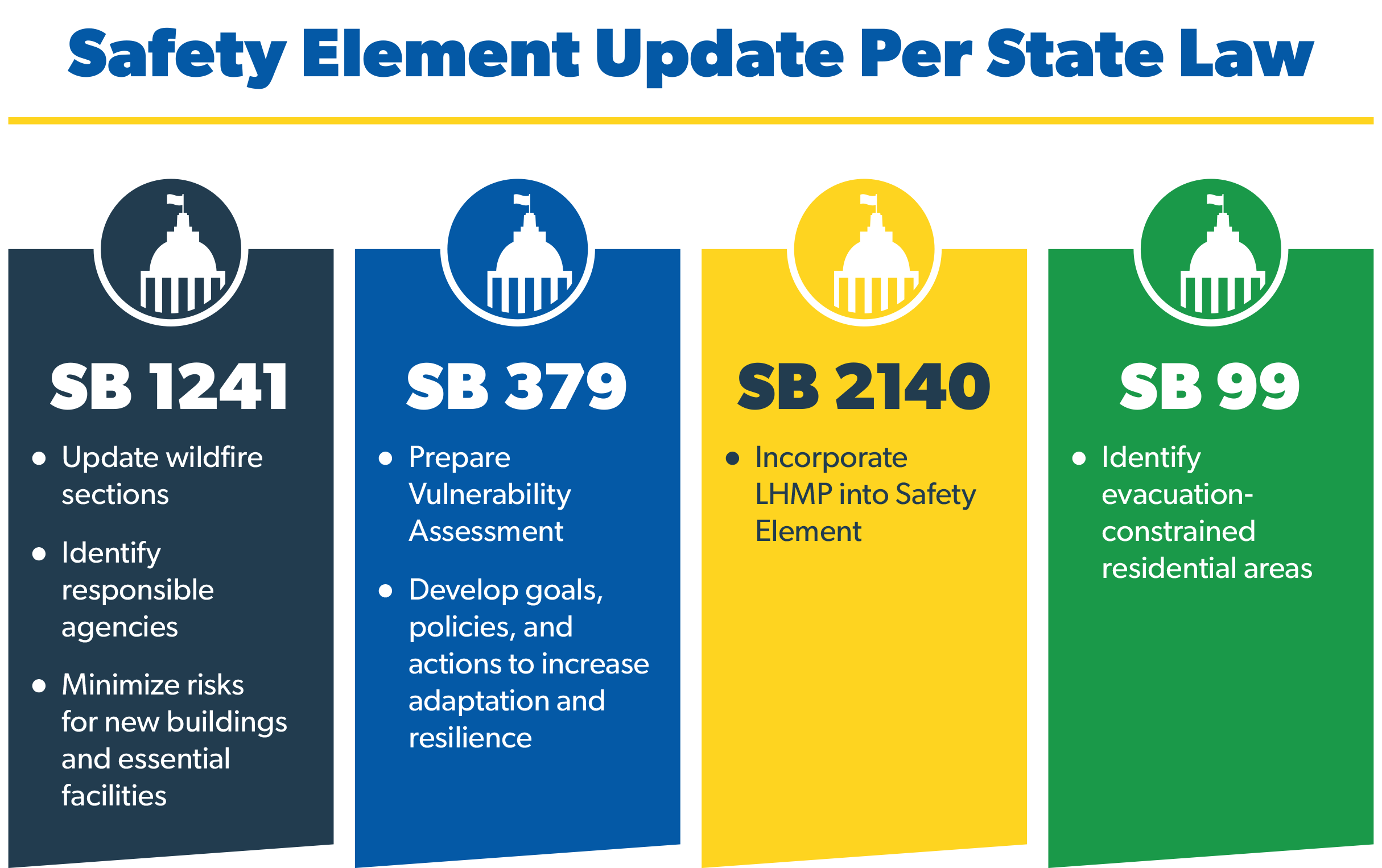
Safety Element Update Process
The primary steps or products of this Safety Element Update process include conducting a Climate Change Vulnerability Assessment, preparing a Background Report and maps, updating the information, goals, policies, and actions in the Safety Element, and sharing each draft product with the community and decisionmakers. Community engagement will be conducted throughout the Safety Element process, with multiple opportunities for community members to provide stories of lived experiences, review materials, and provide feedback that will be integrated into the Safety Element narrative, goals, policies, and programs.
- The Background Report will include descriptions of climate change hazards, along with natural and human-caused hazards not affected by climate change.
- A Climate Change Vulnerability Assessment analyzes how climate change hazards will affect the people, places, systems, and services in a community.
- The Safety Element Update will include updating the text of the existing Safety Element based on the Background Report, and revising goals, policies, and programs to address hazards of concern and vulnerable populations and assets identified in the Climate Change Vulnerability Assessment.
- Community outreach and engagement will include online and in-person meetings and workshops, online tools such as a project website, map viewer, surveys, and other activities, and study sessions and public hearings with planning commissions and city councils or the Board of Supervisors. Atherton, Brisbane, and Pacifica will not be participating in most engagement activities, although residents of these communities are welcome to get involved.
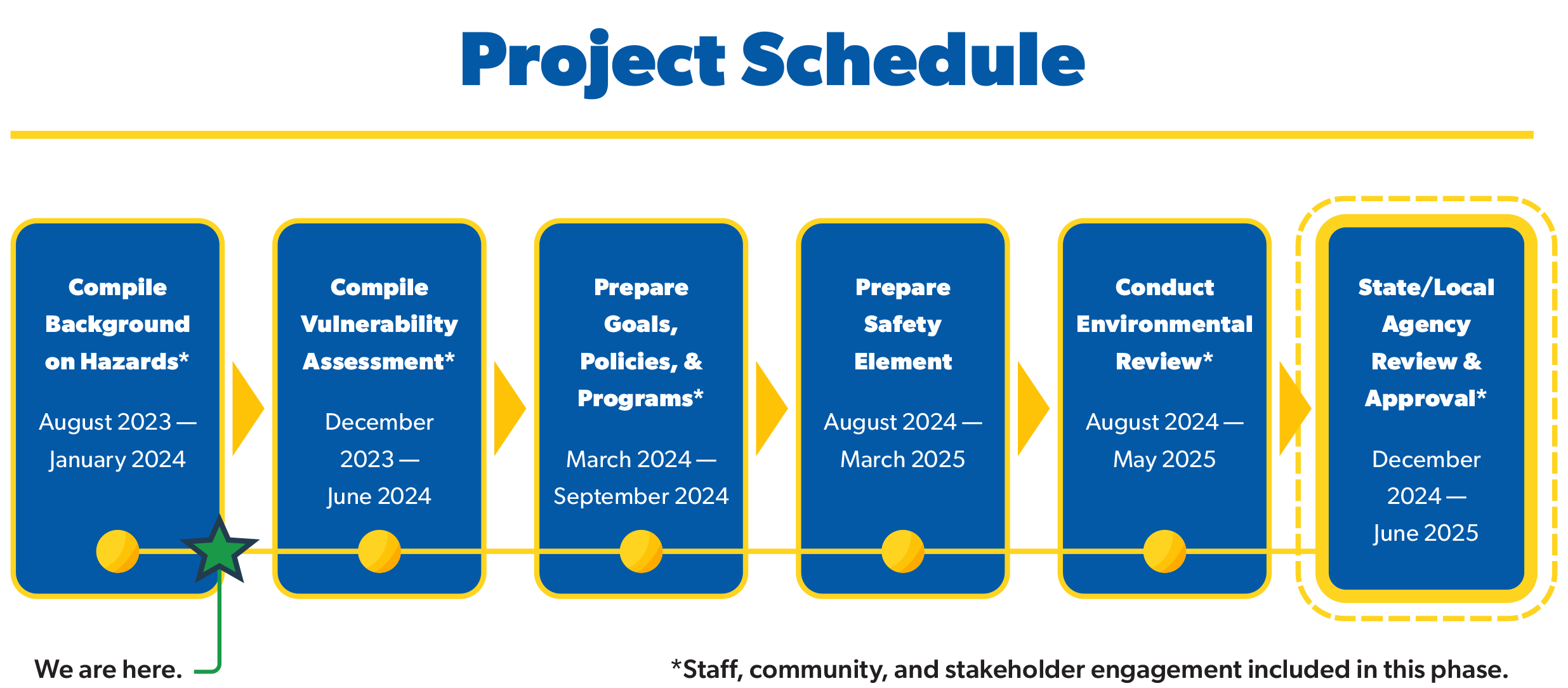
Frequently Asked Questions
The purpose of the PREP project is to identify the biggest hazards facing communities across San Mateo County, evaluate how these hazards may change with the changing climate, recognize the communities and community features that are most vulnerable, and develop strategies for improving community safety and resilience.
Safety Element
The Safety Element is a policy document that discusses a community’s comprehensive public safety approach. It is one of several required elements of a community’s general plan. Other parts of a community’s overall safety framework include the San Mateo County Multijurisdictional Local Hazard Mitigation Plan, which is a more detailed short-term plan that focuses on specific hazard mitigation actions, and individual city and agency emergency operations and evacuation plans. The hazard mitigation plan is updated every 5 years and is reviewed and certified by the Federal Emergency Management Agency. Other components of a community’s hazard resiliency framework include emergency operations plans, evacuation plans, local coastal program policies, water management plans, wildfire protection plans, and climate adaptation plans, among others. The Safety Element will include background information, goals, and strategies from each of these plans and tie into them as appropriate to reduce risks from both natural and human-caused hazards.
The goal of both the Safety Element and MJLHMP is to provide public safety officials and city staff, elected officials, and members of the public with an understanding of the threats from natural and human-caused hazards in the community. However, the Safety Element is a planning document that sets broad goals and establishes policies to help ensure the long-term safety of the community, and the MJLHMP is a short-term document, usually updated every five years, containing specific recommended actions to proactively decrease risks before disasters occur. Additionally, the two documents respond to different sets of regulations. The State sets regulations for the Safety Element, while the federal government sets regulations for the MJLHMP.
Under recent changes to State law, safety elements must be reviewed and updated (as needed) upon each revision of the Housing Element or Local Hazard Mitigation Plan, but not less than every eight years. Due to the recent update of the MJLHMP, several jurisdictions in San Mateo County are reviewing and updating General Plan Safety Elements to be consistent with State law.
Nine jurisdictions in San Mateo County are participating in the PREP project for a coordinated update of their Safety Elements or an analysis supporting their Safety Elements. The PREP project includes San Mateo County, Town of Atherton, and cities of Belmont, Brisbane, Burlingame, East Palo Alto, Half Moon Bay, Pacifica, and San Bruno, with technical support from a consultant team. The County and each of the participating cities will prepare work products for their communities through a collaborative process that shares staff, resources, and outreach. Each community is participating to meet their specific needs and preferences.
The project is guided by a consultant team and a Steering Committee comprised of staff representatives from the participating agencies. The Steering Committee will meet over the course of the project to provide feedback at key points in the process on community engagement and project deliverables; share information about hazards, vulnerabilities, and policy solutions across jurisdictions; and review approaches and concepts to addressing key hazards of concern.
The Safety Elements for each jurisdiction will be reviewed locally by each community’s Planning Commission and City Council or Board of Supervisors. In accordance with State law, the Safety Elements will be reviewed by various State agencies, who may provide comments or recommendations. The California Geological Survey and California Office of Emergency Services will review the Safety Elements for all jurisdictions. CAL FIRE will review the Safety Elements for jurisdictions with land within CAL FIRE-designated State Responsibility Areas (SRA) or locally-adopted Very High Fire Hazard Severity Zones (VHFSZ). According to current SRA and VHFSZ mapping, CAL FIRE will review the Safety Elements for Belmont, Half Moon Bay, and unincorporated San Mateo County, although this may change as new maps are adopted. While the Safety Elements will be reviewed by State agencies, local City Councils or Board of Supervisors will approve and adopt the Safety Element updates into each community’s General Plan.
For many of these communities, there is a significant amount of overlap in the types of hazard conditions they must address, as well as common service providers, natural resources, and infrastructure. A multijurisdictional Safety Element update process builds on the accomplishments of hazard reduction programs and accomplishments across participating jurisdictions, including the recently updated Multijurisdictional Local Hazard Mitigation Plan, and efforts launched by OneShoreline and Climate Ready San Mateo County.
Like the Safety Element, the Environmental Justice Element is part of a community’s General Plan. Learn more about Environmental Justice Element requirements here, and learn more about how to get involved in the local environmental justice planning process here.
Three jurisdictions, Burlingame, East Palo Alto, and San Mateo County, are preparing Environmental Justice elements concurrently with their updated Safety Elements. This is not part of PREP, although the two efforts are closely related. PlaceWorks is the lead technical consultant on both projects, and staff are coordinating regularly and sharing information to ensure that PREP and the Environmental Justice elements work are in sync.
Evacuation Analysis
In 2019, the State adopted Senate Bill (SB) 99, requiring Safety Elements to identify residential areas in any hazard area that lack at least two emergency evacuation routes. This law is intended to help identify evacuation-constrained residential areas. Parcels that lack convenient access to multiple evacuation routes, or to a single evacuation route that would allow them to evacuate in multiple directions, are flagged as potentially evacuation constrained.
Climate Change Vulnerability Assessment
Climate change vulnerability is the degree to which key parts of the community – including infrastructure, buildings, activities, ecosystems, and people – are susceptible to harm from climate change, including their exposure to hazards and any limits on their ability to adapt to changing conditions.
In 2015, the State adopted Senate Bill (SB) 379, requiring Safety Elements to include more information about wildfire hazards, flooding risks, and other short-term and long-term threats posed by climate change. SB 379 mandates that local governments conduct climate change vulnerability assessments as part of their long-range public safety planning efforts and to prepare adaptation and resiliency policies to protect against hazards caused or worsened by climate change.
A climate change vulnerability assessment evaluates the degree to which populations and community assets will be impacted and their ability to adapt to climate change using existing tools and resources. As part of this project, the climate change vulnerability assessments will follow guidance from the California Adaptation Planning Guide with the goal of identifying:
- How climate change hazards may affect different population groups and community assets.
- The degree to which populations and assets are able to prepare for, respond to, and recover from hazard events using existing resources and tools.
- Populations and assets that face the greatest potential harm.
The results of the Climate Change Vulnerability Assessment will be summarized as part of the Safety Element’s Background Report. There is some overlap between the hazards traditionally covered in a Safety Element) and the hazards discussed as part of the Climate Change Vulnerability Assessment. However, the Climate Change Vulnerability Assessment focuses exclusively on hazards that can be directly exacerbated by climate change. The climate change hazards evaluated will be tailored to reflect the unique conditions of each community but may include the following:
The Climate Change Vulnerability Assessment will follow the process outlined in the California Adaptation Planning Guide and will begin by identifying the current risks posed by climate change hazards and how these hazards are likely to change in the future given climate change projections and other considerations. It will identify which populations and assets are likely to be harmed, given their locations, degree of connection, and other factors, collectively known as their exposure. It will next determine how susceptible each population and asset is to each relevant hazard (its sensitivity). Based on these evaluations, the Climate Change Vulnerability Assessment can determine the impact, or the anticipated effects that a population or asset may experience as a result of climate change-related hazards on future conditions. The Climate Change Vulnerability Assessment will then assess the adaptive capacity of all populations and assets for each relevant hazard, determining their ability to resist or respond to the identified potential impacts. Based on the combined impact and adaptive capacity score, the Climate Change Vulnerability Assessment can assess the level of vulnerability for different populations and assets for each hazard.
The climate change vulnerability assessment is a core part of the technical work needed to update the Safety Element. The climate change vulnerability assessment helps community members, agency staff, and decision makers understand how climate change hazards may alter community conditions and what parts of the community (people and places) should be prioritized for adaptation and resilience. The findings from the climate change vulnerability assessment process will be integrated into the Background Report and used to inform the goals, policies, and actions that will be included in the Safety Element.
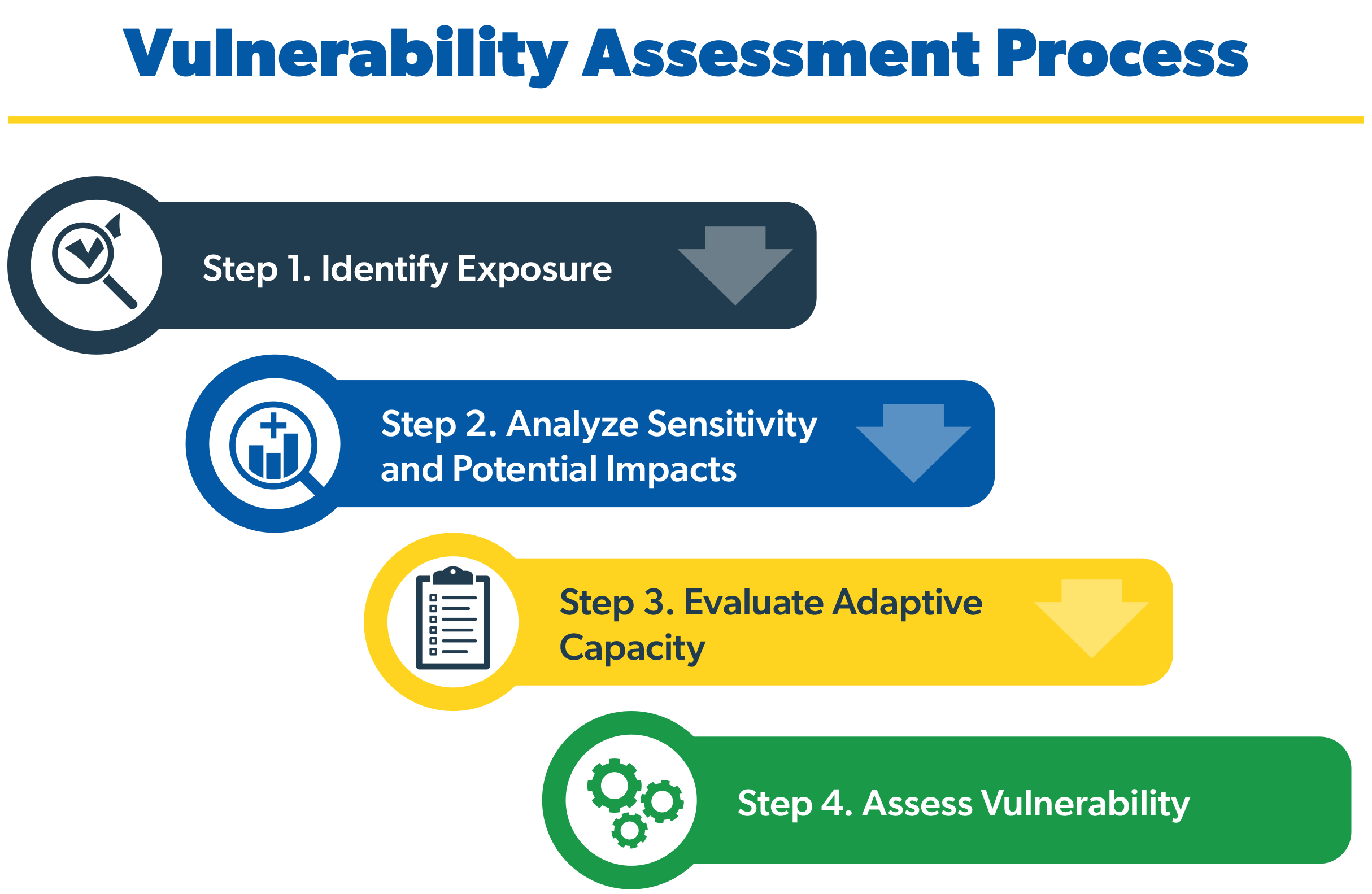
Key Terms and Definitions
Adaptation: Making changes in response to current or future conditions (such as the increased frequency and intensity of climate-related hazards), usually to reduce harm and to take advantage of new opportunities. [i], [ii]
Adaptive Capacity: The combination of the strengths, attributes, and resources available to an individual, community, society, or organization that can be used to prepare for and undertake actions to reduce adverse impacts, moderate harm, or exploit beneficial opportunities. [iii]
Cascading or Compounding Effects: Extreme events that link together hazards over days, weeks, or months, resulting in multiplied effects that cause secondary and sometimes tertiary damage, exceeding the damage of the initial hazard event.
Climate Change: A change in the state of the climate that can be identified by changes in the mean, and/or the variability, of its properties, and that persists for an extended period, typically decades or longer.
Community Asset: A valued feature of a community that may be harmed by climate change. Community assets may include buildings, infrastructure, community services, ecosystems, and economic drivers.
Exposure: The presence of people; infrastructure; natural systems; and economic, cultural, and social resources in areas that are subject to harm. [iv]
Goal: An ideal future end state related to public health, safety, or general welfare.
Hazard: An event or physical condition that has the potential to cause fatalities, injuries, property damage, infrastructure damage, damage to the environment, interruption of business, or other types of harm or loss. [v]
Impact: The effects (especially the negative effects) of a hazard or other conditions associated with climate change.
Policy: A specific statement that guides decision-making, indicating a commitment of the local legislative body to a particular course of action.
Program: An action, procedure, program, or technique that carries out a general plan policy.
Resilience: The capacity of any entity—an individual, a community, an organization, or a natural system—to prepare for disruptions, to recover from shocks and stresses, and to adapt and change from a disruptive experience. Community resilience is the ability of communities to withstand, recover, and to learn from past disasters to strengthen future response and recovery efforts.
Risk: The potential for damage or loss created by the interaction of hazards with assets such as buildings, infrastructure, or natural and cultural resources.
Vulnerability: The degree to which natural, built, and human systems are susceptible to harm from exposure to stresses associated with environmental and social change and from the absence of capacity to adapt. [vi]
Vulnerability Assessment: An analysis of how a changing climate may harm a community and which elements—people, buildings and structures, resources, and other assets—are most vulnerable to its effects based on an assessment of exposure, sensitivity, potential impact(s), and the community’s adaptive capacity.
[i] Louise Bedsworth, Dan Cayan, Guido Franco, Leah Fisher, Sonya Ziaja, “Statewide Summary Report,” in California’s Fourth Climate Change Assessment, publication number: SUMCCCA4-2018-013, 2018.
[ii] California Natural Resource Agency, Safeguarding California Plan: 2018 Update: California’s Climate Adaptation Strategy, 2018, http://resources.ca.gov/docs/climate/ safeguarding/update2018/safeguarding-california-plan-2018-update.pdf
[iii] Intergovernmental Panel on Climate Change, “Annex II: Glossary,” ed. K. J. Mach, S. Planton, and C. von Stechow, in Climate Change 2014: Synthesis Report, ed. Core Writing Team, R. K. Pachauri, and L. A. Meyer (Geneva, Switzerland: IPCC, 2014), p. 117–130, https://www.ipcc.ch/report/ar5/syr/
[iv] Louise Bedsworth, Dan Cayan, Guido Franco, Leah Fisher, Sonya Ziaja, “Statewide Summary Report,” in California’s Fourth Climate Change Assessment, publication number: SUMCCCA4-2018-013, 2018.
[v] California Governor’s Office of Emergency Services, California State Hazard Mitigation Plan, 2018, https://www.caloes.ca.gov/cal-oes-divisions/hazard-mitigation/hazard-mitigation-planning/state-hazard-mitigation-plan
[vi] Neil Adger, “Vulnerability,” Global Environmental Change 16 (2006): 268–281, https://www.geos.ed.ac.uk/~nabo/ meetings/glthec/materials/simpson/ GEC_sdarticle2.pdf
Links, Partners, and Key Documents
San Mateo County Resources
- San Mateo’s County Multijurisdictional Local Hazard Mitigation Plan
- County of San Mateo Sea Level Rise Vulnerability Assessment
- Climate Ready San Mateo County
- OneShoreline
- Planning Policy Guidance to Protect and Enhance Bay Shoreline Areas of San Mateo County
- San Mateo Resource Conservation District
- San Mateo County Forest Health and Fire Resilience Public Works Plan
- Sea Level Rise and Overtopping Analysis for San Mateo County’s Bayshore
State Resources
How You Can Get Involved
Community Workshops
Community Group Meetings
Stakeholder Meetings
Mapped Survey Tool
Planning, Commission, City Council/Board of Supervisors Study Sessions
Public Hearings
Map Survey
We want to know how climate change and natural disasters affect you and others in our communities. Please take our survey to share your thoughts, experiences, and priorities. This will help our team better understand the challenges we all face from these hazards and how the PREP project can help solve them. The survey is available in both English and Spanish.
Community Workshops
We want to hear from community members about their experience and concerns with natural hazards such as flooding and sea level rise, wildfire, earthquakes, extreme heat, landslides, and other forms of severe weather. Join us at an upcoming online workshop to learn about the PREP project and share your thoughts and experiences. Community feedback is critical to our process and we want to hear from you! There will be two Virtual Community Workshops to kick off the project. The workshops will follow the same agenda and include the same activities. Join us at one or both!
Click here to view the workshop presentation materials in English and Spanish. View a recording of the presentation in English and Spanish.
Questions or comments?
Contact the PREP project team using the form below.
Sign up for our mailing list!
Check back here or sign up for notifications to receive details about about the project and future ways to be involved!
Back to Top
